Instructions for Authors
World Journal of Pediatricsis a peer-reviewed journal published by Children's Hospital,Zhejiang University School of Medicine,Hangzhou,China.The journal gives priority to reports of outstanding clinical and experimental works as well as important contributions related to common problems of infants,children and adolescents worldwide.
Submission
Manuscripts should be submitted via the submission system athttps://www.editorialmanager.com/wjop.The address of the editoriais as follows:Children's Hospital,Zhejiang University School of Medicine,3333 Binsheng Rd,Binjiang District,Hangzhou 310052,China.Email:wjpch@zju.edu.cn.
Acceptance
Manuscripts should meet the following criteria:original material,clear writing,appropriate study methods,valid data,and reasonable conclusions supported by the data.In short,they should contain important information or topic of general medical interest.
Peer-review process
All the manuscripts that adhere to its style andInstructions for Authorsare referred to peer-review.Some of them are rejected immediately after an in-house review.The rejection at this stage ismessage.The remaining articles are sent to at least two reviewers expert in the subject.Manuscripts are reviewed with due respectaccording to the response from reviewers,revision by the author(s)and reappraisal on the revision.
The accepted manuscripts are subjected to editorial revision to comply with the requirements on language and style of the journal.The copyright of the accepted and published articles is held by the journal and all the published materials can not be reproduced or published elsewhere,in whole or part,without the written permission from the editor.
Duplicate submission
Manuscripts are considered with the understanding that they have not been published previously and are not under consideration by another publication.The author should alert the editor if the work includes subjects about which a previous report has been published.A research paper submitted to this journal should not overlap by more than 10% with the previously published work or work submitted elsewhere,which would be considered as duplicate publication.If in doubt,authors may forward copies of the published work or material submitted elsewhere to this journal for decision-making.
Proofs and reprints
Upon acceptance of the article,the corresponding author will receive a link to the special Author Query Application at Springer’s web page where you can sign the Copyright Transfer Statement online and indicate whether you wish to orderAuthor Query Application has been completed,your article will be processed and you will receive the proofs.Corrections on the proof should be restricted to errors only and no substantial additions/deletions should be made.No addition or deletion in the names of the authors is permissible at this stage.A copy of the issue carrying the article is supplied free of charge to the authors.Reprints may be ordered on payment in advance.
Categories of Articles
Articles can be considered for publication as editorials,original articles,review articles,special communications,brief reports,letters to editor,commentaries,or clinical image.
Original article
Original articles should report original research relevant to basic and clinical pediatrics including randomized trials,intervention studies,studies of screening and diagnostic tests,cohort studies,reporting randomized controlled trials (RCT),authors must attempt to be in conformity with the consolidated standards of reporting trials (CONSORT) statements.[1]Each manuscript should be accompanied with a structured abstract (divided into background,methods,results and conclusions) in no more thanbe provided in alphabetical order along with the abstract.The text should be divided in sections on introduction,methods,results andmaximum of 5 and 3 respectively.The typical text length for such contributions is 2500-3500 words (excluding title page,abstract,
Research letter:Short accounts of original articles will also be considered for publication as research letters.These focused research letters must not exceed 1500 words,3 illustrations or tables and up to 20 references,preferably recent publications.No abstract should be included.Research letters will be peer reviewed in a manner identical to original articles.
Review article,Systematic review &Meta-analysis
Review articles or systematic,critical assessments of literature are also published.Normally,a review article on a subject already published in theWorld Journal of Pediatricsis not accepted for a period of 3 years.The typical length for reviewreferences.Authors submitting review manuscripts should include a structured abstract of around 250 words describing the need and purpose of review,methods used for selection,extraction and synthesis of data,and main conclusions.While reporting systematic reviews and meta-analyses,authors must attempt to be in conformity with the PRISMA statement(http://www.prisma-statement.org/);a completed PRISMA checklist andow diagram should also be submitted asandow diagram can be downloaded from the PRISMA website (http://www.prisma-statement.org/statement.htm).
Correspondence
Letters commenting upon a recent article in theWorld Journal of Pediatricsare welcome.Such letters should be received within 6 months of the article's publication.At the editorial board's discretion,a letter may be sent to authors/experts for comments and both letter and reply may be published together.Letters may also relate to other topics of interest to pediatricians and others,and/or useful clinical observations.Letters should not be more than 400 words.The number of authors should not exceed 2,including the authors' reply in response to a letter commenting upon an article published in this journal.
Clinical image
A short text of about 150 words depicting the condition with color photographs (vide infra) is needed.Normally only clinical photographs are accepted but accompanying skiagrams or pathological images could also be considered for publication.Photographs should be of high quality,clearly identify the condition and preferably add to the existing knowledge.
Personal viewpoint
Such articles are published on topical pediatric issues including social aspects.It is expected that the authors haveviewpoints.These should not exceed 1500 words.
Preparing Manuscripts
Manuscripts should be prepared in accordance with theUniform Requirements for Manuscripts Submitted to Biomedical Journals.[2]A summary of technical requirements for preparing the manuscript is provided below:
· Double-space throughout the maintext including abstract,each of these sections (in same order) on a new page,numbered consecutively in the upper right hand corner.
· Use at least 11 point font size (Times New Roman or Arial).
· Conventional units are preferred with SI units in parenthesis,if available.The metric system is preferred for the expression of length,area,mass and volume.
· Use nonproprietary names of drugs,devices and other products.
Title page
The page should contain (i) the title of the article:which should be concise but informative (simpler the title the better;preferably it should contain all the key words to help electronic retrieval reliably);(ii) a short running title of less than 40 characters;(iii)initials and surname of each author with the highest academic degree(s) and designation at the time when the work was done;(iv) name,address,telephone,fax,email address of the corresponding author;(v) funding source;(vi) ethical appproval;from any party related directly or indirectly to the subject of this article.";and (viii) contributors' statement.
Authorship
All persons designated as authors should qualify for the authorship.Authorship credit should be based on substantial contributions to (i) concept and design,or acquisition of data,or analysis and interpretation of data;(ii) drafting the article or revising it criticallyversion to be published.Conditions 1,2 and 3 must all be met.Participation solely in the acquisition of funding or the collection of data does not justify authorship.All such people who contributed to the work but do not satisfy all the conditions should be listed in the acknowledgements.Authors are responsible for obtaining written permissions from everyone acknowledged by name.One of the authors shall act as guarantor of the paper and he/she should take the responsibility for the integrity of the work as a whole,from its inception to published article.Authors should provide a description of what each author contributed on the title page.Subsequently,no names can be added or deleted without written permission of the editor.Written consent of authors whose names are being deleted should be obtained.This journal reserves the right to satisfy itselfAll authors must give signed consent to publication (please download from WJP website).
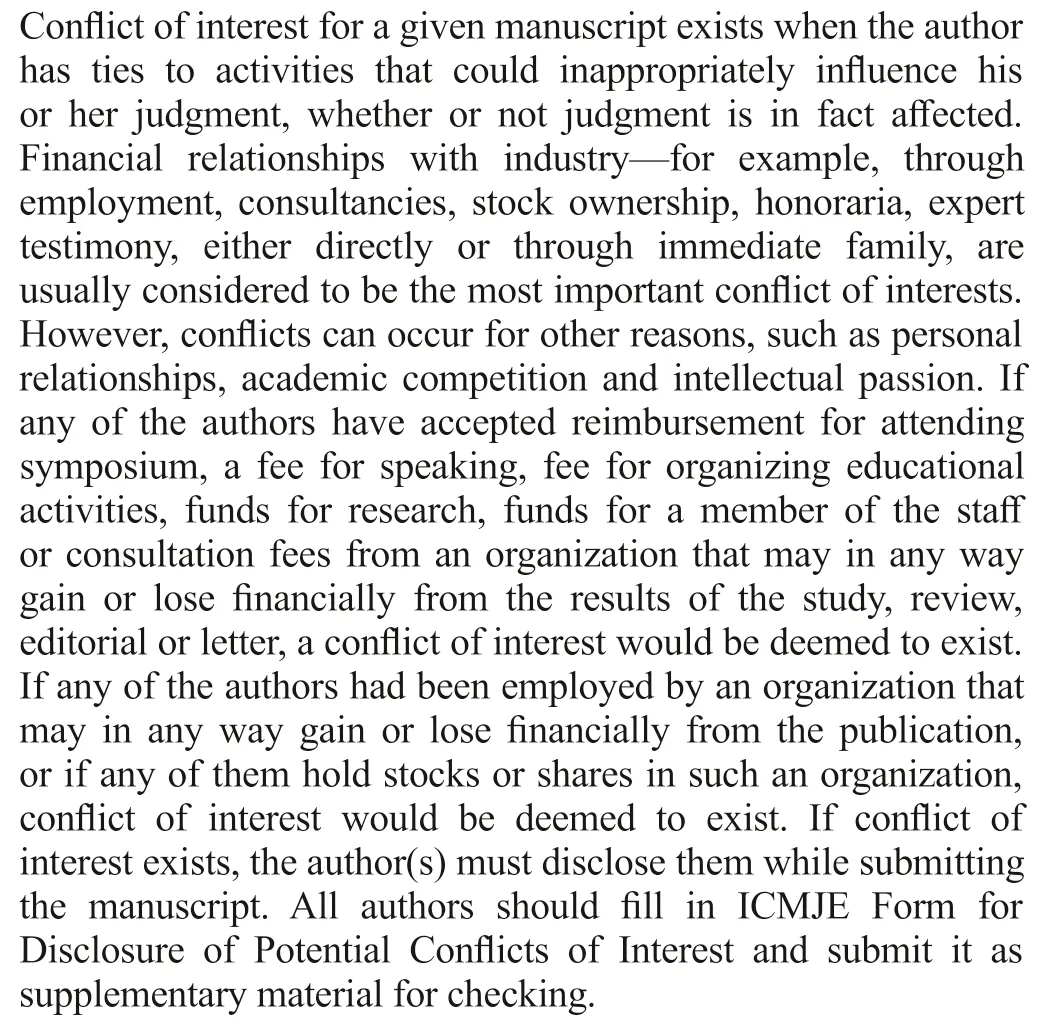
Abstract and key words
The second page should carry an abstract in case of original article (250 words or fewer),review article (250 words or fewer),brief report (100-150 words),respectively.For original article and reviews,the abstract should be structured as detailed earlier.For brief reports,the abstract should state theBelow the abstract,authors should provide 3-5 key words for indexing;terms from the Medical Subject Headings (MESH)list ofIndex Medicusshould be used.
The basic structure of a paper follows the well known acronym IMRAD,which stands for Introduction (what questions was asked),Methods (how was it studied),Results(what was found) and Discussion.[2]
Introduction
The introduction must clearly state the question that the author(s) tried to answer in the study.It may be necessary tothat are essential to justify the proposed study.
Methodology
The methods section should describe,in a logical sequence,how the study was designed (e.g.,how randomization was done),carried out (e.g.,how subjects were chosen or excluded,ethical considerations,accurate details of materials used,exact drug dosage and form of treatment,etc.) and data were analyzed (e.g.,an estimate of the power of the study,exact test used for statistical analysis,etc.).For standard methods,appropriate references areclearly brought out.Authors should provide complete details of any new methods or apparatus used (manufacturer's name and address in parentheses).
Ethics:When reporting experiments on human subjects,authors should indicate whether the procedures followed were in accordance with the ethical standards of the responsible committee on human experimentation (institutional or regional)and with the Helsinki Declaration of 1964,as revised in 2000.[3]They should indicate whether the study was approved by the Institutions' Ethical Committee;and informed consent was obtained for all research individuals.
For all research involving human subjects,informed consent to participate in the study should be obtained from participants (or their parent or legal guardian in the case ofin the manuscript.For manuscript reporting studies involving vulnerable groups (for example unconscious patients) where there is the potential for coercion (for example prisoners) or where consent may not have been fully informed,manuscripts will be considered at the editors discretion.In the case of articles describing human transplantation studies,authors must include a statement declaring that no organs/tissues were obtained from prisoners and must also name the institution(s)/clinic(s)/department(s) via which organs/tissues were obtained.
For reporting the details of individual cases,authors should submit patient’s written consent to publication for evaluation by editors.They should not use patients' names,initials,or hospital numbers,especially in illustrative material.This journal reserves the right to reject a manuscript on ethical grounds,on the basis of recommendations of its "Ethical Committee",even if the research has been cleared by the institutional ethical committee.Moreover,when reporting experiments on animals,authors should indicate whether the institutional and national guide for the care and use of laboratory animals was followed.
Statistics:Authors should describe statistical methods with enough detail to enable a knowledgeable reader with access to the original data to verify the reported results.When possible,indicators of measurement error or uncertainty (such asPvalues are provided rather than stating as just <0.05 or >0.05 etc.References for the design of the study and statistical methods should be to standard works when possible (with pages stated) rather than to papers in which the designs or methods were originally reported.Any general-
Results
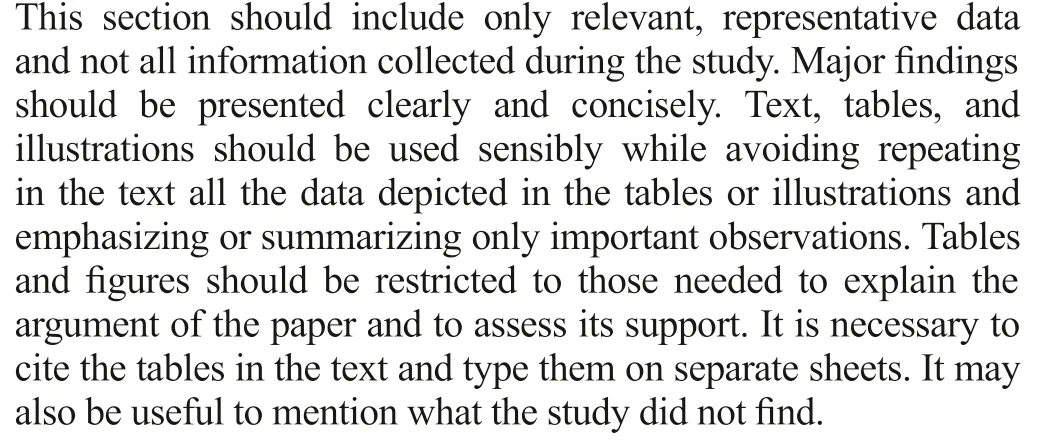
Discussion
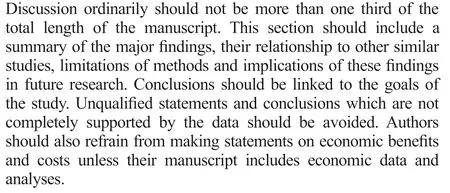
Acknowledgements
In acknowledgements section,it is suitable to list all contributors who do not meet the criteria for authorship,such as a person who provided purely technical help,writing assistance,or a department head who provided only general support.Groups of persons who have contributed materially to the paper but whose contributions do not justify authorship may be listed under a heading such as"clinical investigators" or "participating investigators",and their function or contribution should be described,for example,"served"collected data",or "provided and cared for study patients".A written consent is required from all the persons acknowledged,indicating their acceptance for the same.Acknowledgements section should be placed after the manuscript's Discussion orConclusionsection and before the References section.
References

The titles of journals should be abbreviated according to the style used inIndex Medicus.Authors are required not to use abstracts,unpublished observations and personal communications as references.References to papers accepted but not yet published should be designated as "in press";authors should obtain written permission to cite such paperspublication.
Journal article
O'Mahony S,Rose SL,Chilvers AJ,Ballinger JR,Solanki CK,Barber RW,et al.Finding an optimal method for imaging lymphatic vessels of the upper limb.Eur J Nucl Med Mol Imaging.2004;31:555–63.doi:10.1007/s00259-003-1399-3.
Frumin AM,Nussbaum J,Esposito M.Functional asplenia:demonstration of splenic activity by bone marrow scan.Blood.1979;59 Suppl 1:26–32.
Organization as author
American Academy of Pediatrics.Clinical practice guideline:hyperactivity disorder.Pediatrics.2001;108:1033–44.
Complete book
Department of Health.Shifting the balance of power within the NHS:securing delivery.London:DoH;2001.
Blenkinsopp A,Paxton P.Symptoms in the pharmacy:a guide to the management of common illness.3rd ed.Oxford:Blackwell Science;1998.
Book chapter
Conference proceedings
Kimura J,Shibasaki H,editors.Recent advances in clinical neurophysiology.Proceedings of the 10th International Congress of EMG and Clinical Neurophysiology;1995 Oct 15-19;Kyoto,Japan.Amsterdam:Elsevier;1996.
Dictionary and similar references
Stedman's medical dictionary.26th ed.Baltimore:Williams &Wilkins;1995.Apraxia;p.119–120.
Unpublished accepted material
Leshner AI.Molecular mechanism of cocaine addiction.N Engl J Med.In Press 1996.
Material from Internet
Doe J.Title of subordinate document.In:The dictionary ofSociety of Chemistry.1999.http://www.rsc.org/dose/title of subordinate document.Accessed 15 Jan 1999.
Tables
(i) Each table should be typed in single-spaced and in a 10-or 12-point font on a separate page;(ii) Tables must be numbered consecutively (Roman numerals) in the order ofeach column should have a short or abbreviated heading;(iii) Explanatory matters are placed in footnotes,not in the heading.In footnotes,all nonstandard abbreviations used in each table and any empty cells should be explained adequately.Use superscript letters (a,b,c) to mark each footnote and be sure each footnote in the table has a corresponding note (and vice versa);for explainingPvalues,please use symbols like *,?,?,§,||… (iv) Statisticaldeviation and standard error of the mean.When presenting percentages,include numbers (numerator and denominator);(v) Be sure that each table is cited in the text;(vi) If data are used from another published or unpublished source,it is necessary to obtain permission and acknowledge them fully.
Figures and illustrations
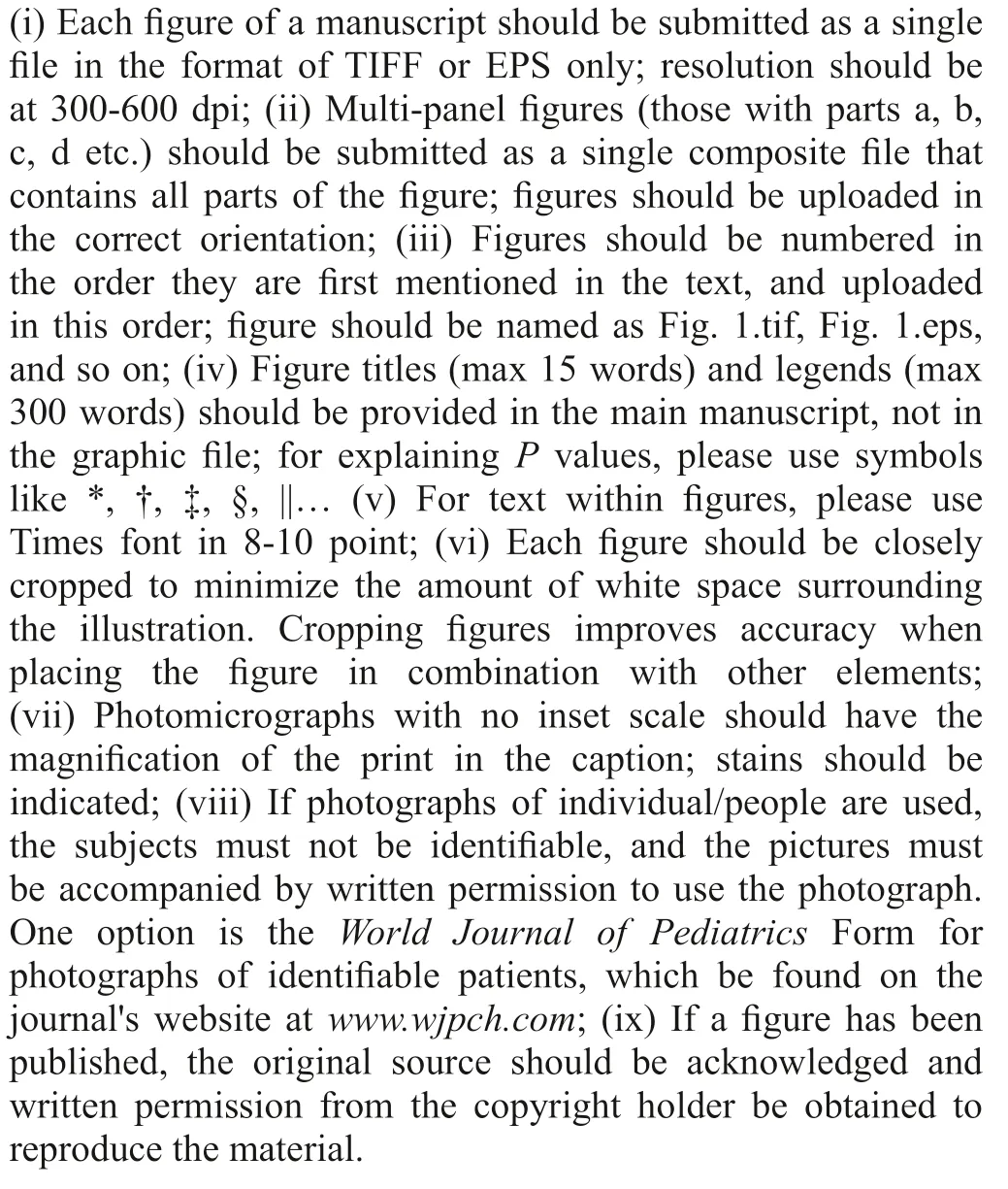
Legends for illustrations
Legends for illustrations should be typed or printed out in double-space,starting on a separate page,with Arabic numerals corresponding to the illustrations.When symbols,arrows,numbers,or letters are used to identify parts of thein the legend.The internal scale should be explained and the
Units of measurement
Measurements of length,height,weight,and volume should be reported in metric units,i.e.,meter(m),gram(g),or liter(L)or their decimal multiples.Milliliter or deciliter should be expressed as mL or dL.Red and white blood cell counts are to be expressed as ×106/μL and ×103/μL respectively.Temperatures should be given in degrees Celsius and blood pressures in millimeters of mercury (mmHg).All hematological and clinical chemistry measurements should be reported in the conventional system or in terms of the International System of Units (SI).
Abbreviations and symbols
Only standard abbreviations are used in the text while avoiding abbreviations in the title and abstract.The full term for which an abbreviation stands should precedemeasurement.Year,month,day,hour,minute and second should be abbreviated as y,mon,d,h,min,and s in tables respectively.
Research Data Policy and Data Availability Statements
A submission to the journal implies that materials described in the manuscript,including all relevant raw data,will be freely available to any researcher wishing to use them for non-commercial purposes,
Data availability
All original research must include a data availability statement.Data availability statements should include information on where data supporting the results reported in the article can be found,if applicable.Statements should include,where applicable,hyperlinks to publicly archived datasets analysed or generated during the study.For the purposes of the data availability statement,“data” isit is not possible to share research data publicly,for instance when individual privacy could be compromised,data availability should still be stated in the manuscript along with any conditions for access.Data availability statements can take one of the following forms (or a combination of more than one if required for multiple datasets):(i) The datasets generated during and/or analysed during the current study are available in the [NAME] repository,[PERSISTENT WEB LINK TO DATASETS];(ii) The datasets generated during and/or analysed during the current study are available from the corresponding author on reasonable request;(iii)All data generated or analysed during this study are included in thisdatasets generated during and/or analysed during the current study are not publicly available due [REASON(S) WHY DATA ARE NOT PUBLIC] but are available from the corresponding author on reasonable request;(v) Data sharing not applicable to this article as no datasets were generated or analysed during the current study;(vi)[THIRD PARTY NAME] but restrictions apply to the availability of these data,which were used under licence for the current study,and so are not publicly available.Data are however available from the authors upon reasonable request and with permission of[THIRD PARTY NAME].More templates for data availability statements,including examples of openly available and restricted access datasets,are available from Data Availability Statements(https://www.springernature.com/gp/authors/research-data-policy/data-availability-statements/12330880).
Data repositories
This journal strongly encourages that all datasets on which the conclusions of the paper rely are available to readers.We encourage authors to ensure that their datasets are either deposited in publicly available repositories (where available and appropriate) or presentedpossible.Please see Springer Nature’s information on recommended repositories (List of Repositories,https://www.springernature.com/gp/authors/research-data-policy/recommended-repositories).General repositories—for all types of research data—such as
Data citation
The journal also requires that authors cite any publicly available data on which the conclusions of the paper rely.Data citationsincluded in the reference list using the minimum information recommended by DataCite,and follow journal style.Dataset
Research data and peer review
Peer reviewers are encouraged to check the manuscript’s data availability statement,where applicable.They should consider if the authors have complied with the journal’s policy on thestudy available for replication or reuse by other researchers.Peer reviewers are entitled to request access to underlying data (and code) when needed for them to perform their evaluation of a manuscript.
This journal uses double-blind peer review.If you are providing reviewers with access to your data (for example via a repository link,supplementary information or data on request),it is strongly suggested that the authorship in the data is also blinded.There are data repositories that can assist with this and/or will create a link to mask the authorship of your data.
Authors who need help understanding our data sharingand sharing research data can access our Author Support portal(https://support.springernature.com/en/support/solutions/folders/6000238326) for additional guidance.
For more information
More information are available fromhttp://www.springernature.com/gp/group/data-policy/faq.
Copyright Transfer
Authors will be asked to transfer copyright of the article to the Publisher (or grant the Publisher exclusive publication and dissemination rights).This will ensure the widest possible protection and dissemination of information under copyright laws.
Open Choice
World Journal of Pediatricsis a subscription-based journal allowing authors to make individual articles gold open access immediately on payment of an article publication charge.Authors can choose to have their article published open access for EUR 2480.Open Choice articles do not require transfer of copyright as the copyright remains with the author.In opting for open access,the author(s) agree to publish the article under the Creative Commons Attribution License.
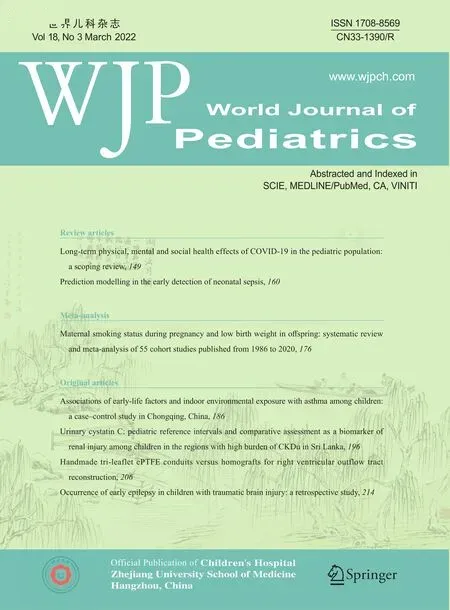 World Journal of Pediatrics2022年3期
World Journal of Pediatrics2022年3期
- World Journal of Pediatrics的其它文章
- Information for Readers
- Editors
- Limited value of procalcitonin,C-reactive protein,white bloodcell,and neutrophil in detecting bacterial coinfection and guiding antibiotic use among children with enterovirus infection
- Sudden unexpected infant death rates and risk factors for unsafe sleep practices
- Towards creation of national cerebral palsy registries in Arab countries:what is missing?
- Occurrence of early epilepsy in children with traumatic brain injury:a retrospective study
